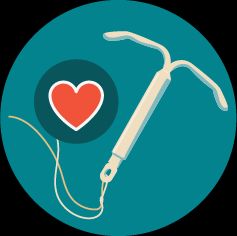You may get pregnant immediately once an IUD is out. Since the IUD stays in the uterus, hormone production related to fertility generally isn’t affected.
When it comes to birth control, an intrauterine device (IUD) is a top pick for those wanting to prevent pregnancy. It’s also a simple method to reverse when you’re ready to start trying for a baby.
There are two types of IUDs: hormonal and nonhormonal (copper).
Both are placed in the uterus and are toxic to sperm and impede fertilization. A hormonal IUD releases small amounts of the hormone progestin to prevent pregnancy — this only gets into the bloodstream in minimal amounts. In contrast, the nonhormonal IUD uses copper, which acts as a spermicide to prevent pregnancy.
The procedure to remove these only takes minutes, and your ability to get pregnant returns almost immediately after IUD removal. Still, pregnancy chances after an IUD may depend on fertility challenges that are unrelated to an IUD.
One of the advantages of using an IUD is how quickly you can conceive after removal. In general, the ability to get pregnant will be what was typical for you before IUD insertion.
You can attempt pregnancy the first month after removing an IUD, says Jessica Scotchie, MD, a board certified OB-GYN and co-founder of Tennessee Reproductive Medicine.
That said, the average amount of time it takes for someone to get pregnant depends on age and other medical and gynecologic factors.
Here, Dr. Scotchie shares general guidelines, timelines, and odds of getting pregnant at various ages:
- Under age 35, there’s a 20% likelihood each month of conceiving, with 60% conceiving by 6 months and 85% to 90% conceiving by 1 year.
- Over age 35, the likelihood of conceiving drops to about 10% to 15% per month.
- Over age 40, the likelihood of conceiving decreases further to about 5% each month.
A doctor may recommend supplementing with folic acid or a multivitamin before IUD removal to prevent neural tube defect risks in future pregnancies. Consider asking a healthcare professional about how early you should start these supplements and what dosage you should follow.
Zaher Merhi, MD, a board certified OB-GYN and fertility expert, says that there’s no increased risk of ectopic pregnancy after IUD removal.
However, he does point out that if you get pregnant while an IUD is still in the uterus, you may have a higher chance of having an ectopic pregnancy.
And if you’re hoping for twins, don’t count on prior use of an IUD to increase your chances. Dr. Merhi says there are no higher percentages of twins associated with IUD use.
Difficulty getting pregnant after IUD removal may have nothing to do with an IUD. In most circumstances, birth control methods don’t delay fertility.
According to a
In fact, of the 14,884 women included in the study review, 83% were able to get pregnant within the first 12 months after contraceptive discontinuation. This includes the removal of IUDs, with 2,374 women making up the group of IUD users.
With that in mind, Dr. Scotchie says if you have any underlying fertility problems that wouldn’t necessarily present when an IUD is in place — such as ovulation irregularity, heavy and irregular periods, or pelvic pain — your chances of conceiving may be affected. But these things wouldn’t have been caused by IUD use.
“Anyone with irregular cycles, heavy, painful menses, or who has been trying to conceive for 12 months without success (if under 35 years old) or 6 months without success (if over 35 years old) should see a physician,” explains Dr. Scotchie.
Another reason you may not be getting pregnant after IUD removal, says Dr. Merhi, is possible scarring in the uterus from the IUD itself. “This is especially true if you had any type of infection, which could cause difficulty conceiving and might increase the chance of a miscarriage,” he says.
Dr. Scotchie says you can remove an IUD at any time. If you don’t wish to get pregnant, you need to use another form of contraception, such as condoms or birth control pills.
You may want to talk with a doctor ahead of time to determine the right method of birth control for you. Examples of other reversible methods include:
- oral contraceptives
- birth control implant or shot
- patch
- ring
- diaphragm
- cervical cap
- condoms
- spermicide
If you want to start trying for a pregnancy within a few months after IUD removal, the type of birth control method you use before that may be a factor. If that’s your goal, it’s a good idea to let the doctor know.
If baby-making is in your future, you can make an appointment with a doctor to discuss IUD removal. They can help you:
- decide when to remove an IUD
- know what to expect in the fertility department
- figure out how long it may take to get pregnant
- understand how to prevent pregnancy if you want to wait a few months to try after removing an IUD




